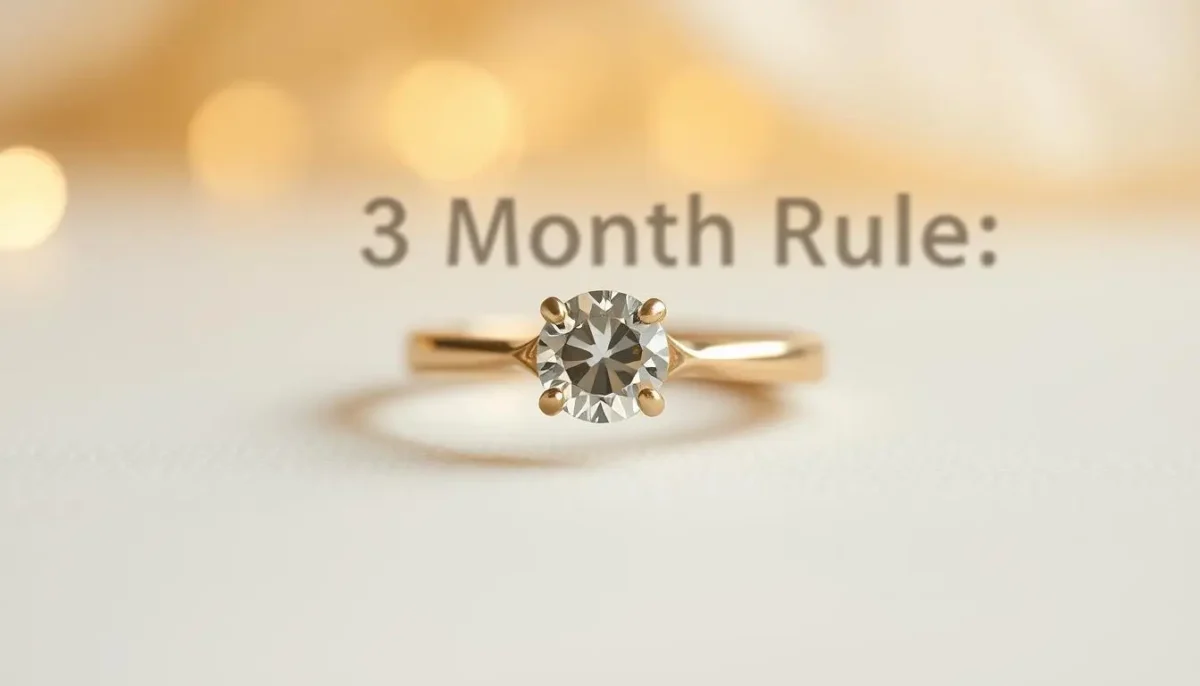What is the 3 month rule for ring? 💍 It’s a traditional guideline suggesting that you should spend three months’ salary on an engagement ring. This idea was popularized by diamond marketing campaigns in the mid-20th century and has influenced how many people think about ring budgets. In today’s world, however, the 3-month rule is more of a suggestion than a requirement. In this article, we’ll look at the history of the rule, whether it still applies, and how to decide on a budget that works for you.
The idea of how much to spend on an engagement ring is often debated. The 3 month rule for ring says a man should spend about 3 months’ salary on it.
This rule started with a De Beers marketing push in the 1930s. They wanted to make diamonds seem rare and valuable.
Couples thinking about getting engaged should know about this rule. It’s important today.
Key Takeaways
- The 3 month rule for ring is a tradition that suggests spending 3 months’ salary on an engagement ring.
- The rule originated from a De Beers marketing campaign in the 1930s.
- Understanding this rule is key for couples planning their engagement and wedding.
- The rule’s importance today is a topic of debate among couples and financial advisors.
- The tradition is linked to buying an engagement ring.
Understanding the 3 Month Rule for Engagement Rings
The 3 month rule has been a big deal in buying engagement rings for a long time. It says you should spend 3 months’ salary on a ring. But where did this idea come from, and why is it so important in choosing engagement rings?
Definition and Basic Concept
The 3 month rule is all about a financial guide for buying engagement rings. It helps people figure out how much they should spend based on their income.
This rule means the ring’s quality and price should match the buyer’s income. It’s meant to make choosing a ring easier.
Historical Context of the Rule
The 3 month rule started with a De Beers marketing push in the late 1930s. Their famous “A Diamond is Forever” slogan helped make diamonds seem rare and valuable.

This campaign was a huge success. It not only boosted diamond sales but also made diamond engagement rings a cultural norm. The 3 month rule became a key part of this trend.
Knowing the 3 month rule‘s definition and history shows its big role in engagement ring tradition. It’s more than a simple rule; it shows how marketing can influence our choices and cultural values.
What is the 3 Month Rule for Ring? Origin and Evolution
De Beers started the 3-month rule in the 1930s. This campaign changed how people see diamond engagement rings. It also created a lasting cultural trend.
The famous slogan “A Diamond is Forever” was part of this campaign. It made diamonds seem rare and valuable. De Beers linked diamonds to eternal love, making them seem more precious.

De Beers Marketing Campaign Origins
The De Beers campaign was a strategic move to control the diamond market. They created a fake scarcity to set diamond prices. This made diamonds a symbol of love and commitment, expected to be pricey.
This campaign aimed to shape the culture around engagement rings. It suggested a man should spend three months’ salary on a ring. This linked the ring’s value to the depth of love and commitment.
How the Rule Became a Cultural Expectation
The 3-month rule grew from a marketing tip to a cultural norm. This change was helped by social pressures and the ring industry. Now, spending less than three months’ salary is seen as less committed.
The rule’s influence comes from societal norms and media. It has shaped how couples buy engagement rings, even though it started as a marketing idea.
Financial Implications of the 3 Month Rule
For couples planning their future, understanding the 3-month rule’s financial impact is key. This rule suggests spending three months’ salary on an engagement ring. But, following this rule can be very costly.
Budgeting Considerations
When buying an engagement ring, budgeting is essential. Couples must balance their desire to follow the 3-month rule with their financial situation and goals.
Economic Impact on Couples
The 3-month rule can have a big economic impact on couples. It can cause financial stress if not managed well.
Debt and Long-Term Financial Planning
Following the 3-month rule might lead to debt for couples. It’s important to plan for the long term to avoid financial problems.
The key is not to prioritize spending based on societal expectations but to make financial decisions that align with your personal values and goals.
“The key is not to prioritize spending based on societal expectations but to make financial decisions that align with your personal values and goals.”
To understand the financial impact better, let’s look at a comparison:
| Financial Aspect | Adhering to 3-Month Rule | Personalized Budgeting Approach |
|---|---|---|
| Average Spend | $5,000 (based on $60,000 annual salary) | Variable, based on couple’s financial situation |
| Financial Strain | High | Low to Moderate |
| Debt Incurrence | Possible | Less Likely |
| Long-Term Impact | Potential negative impact on savings and investments | More likely to support long-term financial goals |
Modern Perspectives on the 3 Month Rule
The 3-month rule is changing to meet today’s couples’ needs. As society and money matters evolve, views on this rule are shifting. This is true, mainly for younger people.
Changing Attitudes Among Millennials and Gen Z
Millennials and Gen Z are changing what engagement rings mean. They look at their money, values, and culture. Now, they choose what fits them best, not just a set rule.
Financial pragmatism is a big reason for this change. With high living costs and student loans, they focus on being financially stable. This might mean waiting to buy a ring or choosing something less expensive.
Cultural Variations in Ring Spending
How much to spend on a ring varies by culture. The 3-month rule is common in some places but not others. For example, some cultures value the wedding more than the ring.
- In some Asian cultures, the focus is on the couple’s future together, not the ring’s price.
- In Western cultures, the quality and size of the diamond are key.
- Some couples choose lab-grown diamonds or other gemstones for their affordability and sustainability.
Partner Communication About Ring Expectations
Talking openly is key when dealing with the 3-month rule. Couples discuss their ring hopes, money comfort, and likes. This helps avoid misunderstandings.
Honest dialogue helps ease pressure. It lets couples explore options like saving for a ring or picking something more affordable.
By understanding each other, couples make choices that suit both. This way, they avoid following an outdated rule.
Alternatives to the 3 Month Rule
Couples today are looking beyond the 3-month salary rule for the perfect engagement ring. They want something more personal and affordable. This change is about finding a ring that fits their unique financial situation.
Personalized Approaches to Ring Budgeting
One big alternative is a personalized budgeting approach. This means setting a budget based on what each person can afford. It’s not just about following a rule.
Couples can look at their savings, income, and other bills to figure out a budget. Some might spend a certain percentage of their income. Others might save for a bit longer. This way, they make a choice that feels right for them.
Ethical and Sustainable Ring Options
More couples are choosing ethical and sustainable ring options. They want rings that show their love and match their values. This includes rings that are good for the planet and people.
They might pick conflict-free diamonds, recycled precious metals, or lab-grown gemstones. These choices are better for the environment and ensure the ring’s story is honest.
Heirloom and Vintage Alternatives
Some couples prefer heirloom and vintage rings over new ones. These rings have a special history and unique charm.
Going for an heirloom or vintage ring is also kinder to the planet. It means less mining and manufacturing. Plus, these rings can become family treasures for years to come.
Investment Considerations for Couples
When looking at alternatives, couples should think about the investment value of their ring. Some rings, like those with rare gemstones, might increase in value.
But, not all engagement rings are investments. It’s key to understand this. Couples should weigh their emotional wants against practical financial needs when choosing a ring.
Conclusion
Couples thinking about the 3 month rule for engagement rings need to know its history and what it means today. This rule started with De Beers’ marketing but has become a big part of our culture.
Looking at the money side and today’s views on the 3 month rule helps couples make smart choices. Knowing where this rule comes from and how it varies can give couples a better understanding.
The 3 month rule isn’t for everyone. Couples should think about their own situation, what they value, and their budget when picking an engagement ring. It’s not just about the price. What matters most is the love and thought behind the ring, whether it’s a diamond or something special from the past.
FAQ
What is the 3 month rule for rings?
The 3 month rule for rings means you should spend about 3 months’ salary on an engagement ring. This idea started with a De Beers marketing campaign in the 1930s.
Is the 3 month rule for rings relevant today?
The 3 month rule’s relevance varies among couples. Some stick to it, while others adjust it based on their financial situation and values.
How did De Beers influence the 3 month rule?
De Beers’ 1930s marketing made diamonds seem rare and valuable. This created the idea that spending 3 months’ salary on a ring was the norm.
What are some alternatives to the 3 month rule?
Couples can explore other ways to budget for rings. Options include choosing rings that are ethical, sustainable, or even vintage. They can also consider the ring as an investment.
How can couples communicate effectively about ring expectations?
Couples can talk openly about their financial situation, values, and ring expectations. This ensures they are both on the same page.
Are there cultural variations in ring spending?
Yes, different cultures have their own ring spending traditions. Couples should consider these when deciding on their ring purchase.
What are the financial implications of adhering to the 3 month rule?
Following the 3 month rule can affect your finances. It can impact your budget, lead to debt, and require long-term financial planning.

